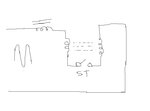ahsan_i_h
Full Member level 5
- Joined
- May 18, 2012
- Messages
- 290
- Helped
- 80
- Reputation
- 160
- Reaction score
- 77
- Trophy points
- 1,308
- Location
- Bangladesh
- Activity points
- 3,245
Hello everybody
For a 220v conventional ballast(electrical), starter, fluroscent tube system, during starting, Why ballast kick voltage(appx 1000v) do not get bypassed through starter? We know that starter threshold voltage is lower than 220v.
For a 220v conventional ballast(electrical), starter, fluroscent tube system, during starting, Why ballast kick voltage(appx 1000v) do not get bypassed through starter? We know that starter threshold voltage is lower than 220v.
